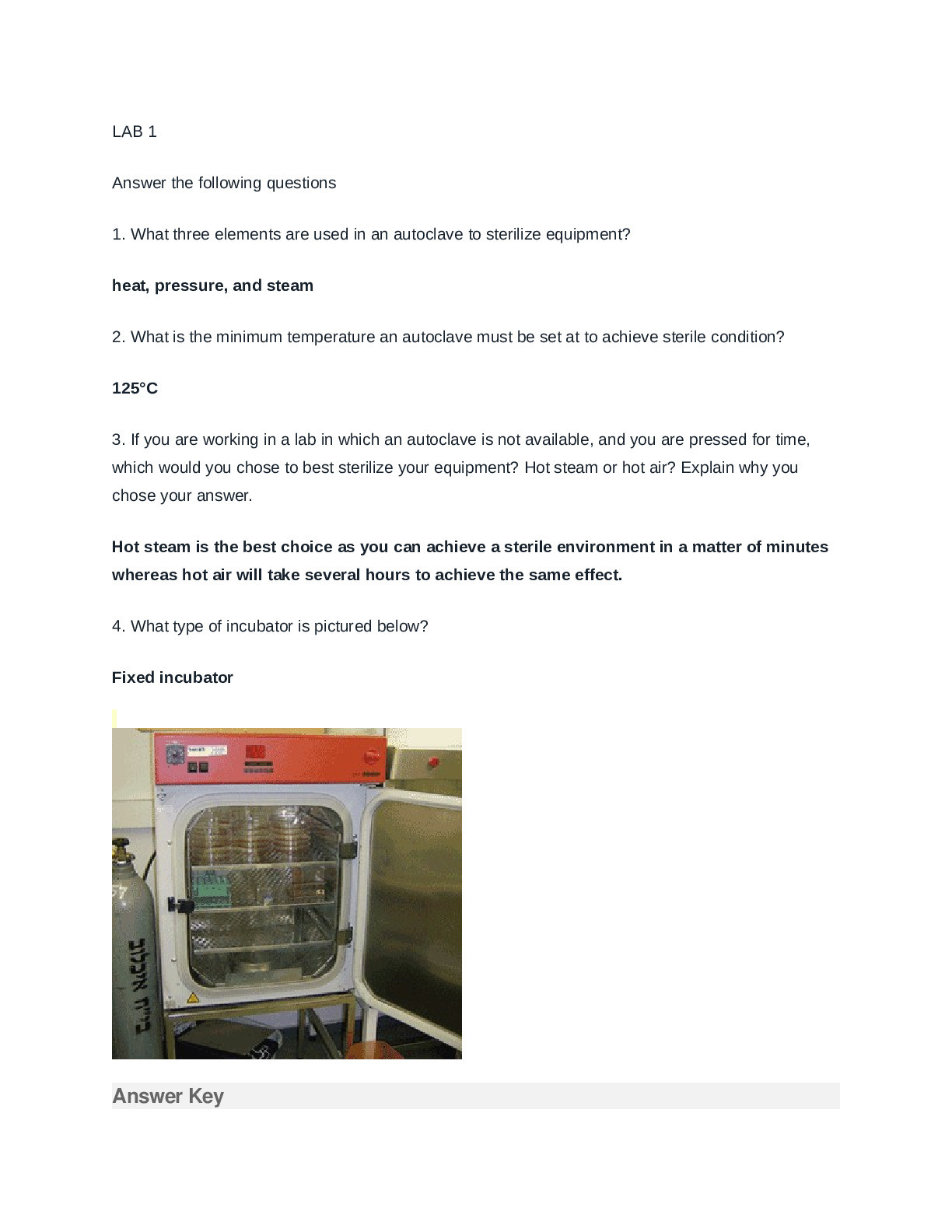Sample Questions
LAB 1
Answer the following questions
1. What three elements are used in an autoclave to sterilize equipment?
heat, pressure, and steam
2. What is the minimum temperature an autoclave must be set at to achieve sterile condition? 125°C
3. If you are working in a lab in which an autoclave is not available, and you are pressed for time, which would you chose to best sterili
...[Show More]
Sample Questions
LAB 1
Answer the following questions
1. What three elements are used in an autoclave to sterilize equipment?
heat, pressure, and steam
2. What is the minimum temperature an autoclave must be set at to achieve sterile condition? 125°C
3. If you are working in a lab in which an autoclave is not available, and you are pressed for time, which would you chose to best sterilize your equipment? Hot steam or hot air? Explain why you chose your answer.
Hot steam is the best choice as you can achieve a sterile environment in a matter of minutes whereas hot air will take several hours to achieve the same effect.
4. What type of incubator is pictured below?
Fixed incubator
Answer Key
Answer the following questions.
1. At what temperature is the fixed incubator set to, as presented in the lab video?
37°C
2. At what temperature should you refrigerate bacterial samples? Explain why this is beneficial.
4°C. This temperature slows bacterial growth and prolongs the life of the sample.
3. What are the FOUR types of gloves presented in the lab video?
Latex, Nitrile, Thermal cold, Thermal heat
4. What THREE rules were discussed in regards to lab safety that would protect you and others from contamination?
1. Never eat or drink in the lab
2. Always wear appropriate PPE
3. Never leave the lab wearing PPE
5. What are the main sections that should be found in a lab notebook? Name at least 4.
Objective, Procedure, Notes, Results and Deviations
Answer the following questions.
1. You are a lab instructor and Sally Miller has turned in her lab notebook for you to grade the lab experiment #1 on lab safety. Based upon what was covered in the lab video, how should Sally have entitled her experiment?
SM01 Lab Safety
2. You arrive to your first day of work at a new lab. You are taking over for someone who took a new job at another lab. Your boss informs you that because of time restraints, this person did not exactly follow the experimental protocol. In order to proceed, you must know what he did differently. (1) According to the lab lecture, under what section of his notebook would you look to find the
experimental steps? (2) As changes to the experimental steps were made, what are these differences called and how should it appear in the lab notebook?
(1) Procedure—this is where the steps for the experimental protocol are recorded.
(2) Deviations. All deviations should be written in red to immediately bring attention to the changes in the protocol.
LAB 2
1. Identify the part of the microscope indicated by the arrow.
Oculars (or eyepiece)
2. Identify the part of the microscope indicated by the arrow.
Objectives (or objective lens)
3. Identify the part of the microscope indicated by the arrow.
Course focus
1. You are about to study a bacterial sample under a light microscope. You look into the oculars and see two circles. What adjustments need to be made?
Compress or expand the oculars until a single circle can be seen while using both eyes simultaneously.
2. What 2 parts of the microscope contributes to the total magnification to your sample?
Objective and oculars (eyepiece)
3. As you looking through the microscope you wish to dim (or limit) the amount of light entering into the eyepiece—what component of the microscope other than the light source itself can be adjusted to make these modifications?
Diaphragm
1. What objective power is best suited if you are uncertain what the sample is and where to begin?
4x (or lowest power objective)
2. You are viewing a sample of bacteria that is 3 mm in diameter through a 40x objective lens. The eyepiece has a magnification power of 10x. What size will the sample appear through the eyepiece?
1200 mm in diameter (or 400x’s larger)
3. Based on the microscope shown in the lab lecture, which objectives would NOT require placing oil on the slide?
4x, 10x and 40x
LAB 3
1. List the 4 main steps used to prepare a DRY mount and indicate which step is optional.
1 – Clean slide
2 – Circle area on slide for specimen placement (OPTIONAL) 3 – Apply organism to slide
4 – Air dry at room temperature
2. Why is it important to first clean your slide before applying your sample?
You must first remove any unwanted contaminants from the slide otherwise it may be difficult to distinguish between the pathogen of interest and a contaminant.
3. When performing a wet mount technique, what is the advantage of using a wax or hydrophobic pen?
[Show Less]
